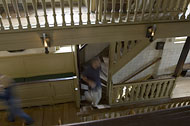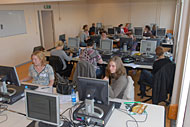Preventive Conservation in the Context of a Historic House Museum: A Case Study

|
|
Overview
This case study is a collaborative project of the Getty Conservation Institute, the Netherlands Institute for Cultural Heritage (ICN), and the Amsterdam-based house museum Ons' Lieve Heer op Solder (Our Lord in the Attic).
It has been designed as a didactic tool for use in academic programs in conservation, museum studies, architecture, or engineering, and can also be used in short courses and workshops dealing with these topics.
The case study provides an important opportunity for students to explore the complexities involved in weighing options and making decisions about environmental control and use of historic spaces and collections, particularly in situations in which no clearcut right approach is apparent. The case integrates the expertise and viewpoints of other professionals, requiring students to consider conservation issues from several perspectives.
Summary
As is the case with many historic house museums, the mission of Our Lord in the Attic Museum is to balance preservation with access. However, increasing visitation levels have seriously challenged efforts for both conservation and visitor enjoyment of the museum. The case study investigates the impact of visitation on the conservation of the physical fabric of the museum's building and collections, and examines how these affect visitor appreciation of the museum. It takes into account the preservation of values and significance as identified and interpreted by museum personnel, with special attention to the use of the building and its contents in its original function as a church. Ultimately, this case study illustrates a decision-making process for managing visitation and use.

|
|
The property, a typical Amsterdam merchant's house, is located in the historic center of Amsterdam and dates back to the sixteenth century. It was extended in 1629 to include a larger house at the front and two houses at the rear (with entrances in an adjacent alley). The floors from the third level and up connect and cover all three houses. From 1661–63, these attics were converted into a church with two galleries that could seat approximately 150 people. The church served the Catholic community from 1663 until 1887, when its much larger successor, St. Nicolas Church, was dedicated. In 1888 the building opened to the public as a museum.
Due to the political situation in the Dutch Republic in the seventeenth century, the open practice of the Catholic religion was officially prohibited. However, many Catholics practiced their faith clandestinely. As a result, private churches were not unusual in the northern Netherlands during this time. The authorities often turned a blind eye in return for small favors, as long as the clandestine churches could not be recognized from the outside. It was not until 1795 that all religions were given the freedom to worship openly.
 |
 |
The museum aims to keep alive the cultural and religious heritage of Catholic Amsterdam through care of the building and its connected arts and decorative arts collection. In addition, it wants to be a hospitable and inspiring meeting place where visitors can share experiences and where religious intolerance is contested.

|
|
The building, with its interiors, is considered the most important part of the museum's collection. The moveable collection consists of seven thousand objects, which are used to decorate period rooms and to illustrate educational themes. The museum reinstated the use of the church in 1951, and about ten masses a year are celebrated there, as well as approximately thirty weddings and baptisms. During services, the organ and a few religious objects from the collection are used. The church also hosts lectures and musical events, for which the organ may be used. In addition, the museum engages in special activities for the public, such as Open Monuments Day and Museum Night, which attract large numbers of visitors.

|
|
With increasing visitor numbers, the museum staff has concerns about the impact of visitors on important values, as well as on the physical well being of the building and its collection. The staff's main concerns regarding the physical care of the museum include: the effect of visitors on the relative humidity, temperature, and carbon dioxide levels in the building when the church is in use, and their indirect affect on the condition of the collection; visitor safety and comfort issues; and wear and tear on the building.

|
|
The underlying research in this case study encompasses investigation of the present and past indoor climates, and the affect of current visitation levels and use on the indoor climate. In addition, a condition assessment was carried out in order to better understand the building's performance and to document the present condition of the building, its interior, and the collection, together with their susceptibility to agents of deterioration relevant to visitation. Combined with an assessment of the museum's organizational environment, the information provides the basis for decision-making that takes into account the sometimes competing requirements of the building, the collection, and visitor management.
The case study was field tested June 19–24, 2008 by students from the University of Amsterdam and the Reinwardt Academie (Amsterdam).
NOTE: Online Teaching Notes for the case study are available to educators via a free online registration.
 |
 |
Last updated: April 2009